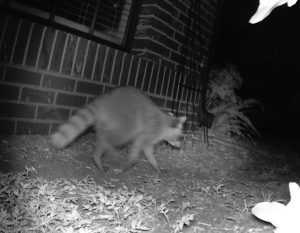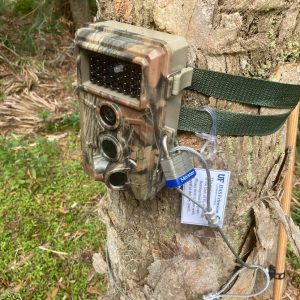Let me tell you a story… About two years ago my wife and I had the unfortunate circumstance to have scurrying little feet running through our attic. We knew it was an animal but did not know which kind if there was more than one, and how it was getting into the home. We investigated pest control companies and discovered it would be very expensive to get this problem taken care of. Being an outdoor educator, I knew about trail cameras but did not own one. A trail camera is a remotely triggered camera that is weatherproof, and it snaps a picture based on motion or heat-activated sensors. It can take clear photos and videos in complete darkness. These are commonly used by hunters and conservationists.

We were able to pick up one of these cameras for under $75 and install it around the outside of the house, moving it from place to place on a tripod, until we found out what was going on. It was a pesky raccoon family coming in under the eaves through the soffit. We then moved the camera inside the house into an attic access point and discovered a mama raccoon with three babies.
We ended up calling a trapping company and it cost us almost $1,000 to have the animals relocated and the mess cleaned up.
During our investigation, we discovered that not only did we have raccoons in the yard, but opossum, armadillo, stray cats, flying squirrels, and others. All of these little critters came out after dark! It was amazing what kind of activity we had in our yard! Mind you, we do not live in the country, but in a well-established suburban neighborhood.
Teaching Kids Wildlife Identification

Being an outdoor educator, I thought what a great opportunity it would be to teach young people about wildlife using one of these trail cameras. So, we did!
The 4-H Youth Development program in Brevard County has been teaching a unit called ‘Creature Features’ in the school system for several years. We have worked with many youth ages 6 through 10, who have not experienced significant time outdoors, and cannot recognize common “wild” mammals, birds, and other “critters”. Because every child cannot have an outdoor experience to learn to identify wildlife species, this project brings pictures, artifacts and stories of the animals to them. Wildlife that may be in their own backyard or school ground, that are not normally seen, can now be shown to these young students! This is one way Brevard County 4-H is addressing an issue known as a nature-deficit disorder-1, in which children are not being raised with an understanding or appreciation of their natural world.
Trail Cameras At The Schools
The focus of the project is to place trail cameras on school property where animals may roam and take pictures of their movement after school hours when children are not present.
The objective of the project is to give youth an opportunity to make animal observations and understand animal movement over time, to establish population and frequency, and to apply wildlife biology to computer science and artificial intelligence (AI) to identify the animals before they even see them.
Once these remote pictures are taken, they will be analyzed and screened by educators and presented to the students for wildlife observation and education. The pictures can then be uploaded to scientific software, which will also identify each species with computers to confirm.

At each school, UF/IFAS Extension Brevard County 4-H will provide hardware, initial supplies, and training to teachers and their students, follow-up instruction to conduct observations and data recording, and provide a platform to store and analyze wildlife images.
Teachers will be responsible to train and supervise students in the task of wildlife monitoring, recording, and reporting, they will be responsible for the safekeeping of the equipment that has been checked out to them and share this project experience with peers to help recruit other educators to broaden the scope of the project to include more teachers and youth. Next semester, we’ll move to other schools to continue the project.
Acknowledgments
Brevard County 4-H wishes to acknowledge community project supporters and educators that are seeing this project get off the ground, tested, and hopefully continued. We especially wish to recognize WildlifeInsights.org-2 for their AI technology, Dave Martin (@huntingfarmer) for his camera donation, and the UF/IFAS Rangeland Wildlife and Ecology Lab for their assistance in transferring this technology from the lab to the K-12 classroom. Samples of the wildlife footage collected can be viewed on our Brevard County Extension YouTube channel.
Sources
-1 Louv, Richard. (2005) Last Child in the Woods: Saving Our Children from Nature-Deficit Disorder (Paperback edition). Algonquin Books. 335pp.
-2 Conservation International© 2019, 2011 Crystal Drive, Suite 500, Arlington, Virginia 22202, USA, on behalf of Wildlife Insights and the WI Core Members
About 4-H
4-H is an educational program designed to meet the needs and interests of youth ages 5-18. 4-H members, parents, and volunteer leaders have great fun learning and working together on county and club activities, group projects, special interest clubs, and state events. Specifically, 4-H programs help youth develop life skills such as leadership, communication, and problem-solving while they gain knowledge and skills in various project areas including STEM, healthy living, and citizenship.
If readers would like more information, they may contact Brevard County 4-H at the UF/IFAS Extension Brevard County Office at 321-633-1702.
 5
5
